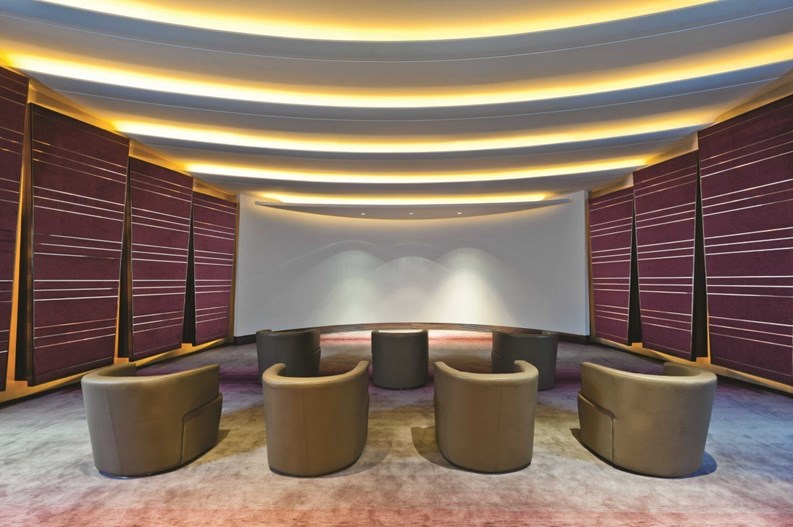The latest boom of luxury real estate development in New York City seems to have sent seismic waves across the Northeast. In the past five years, luxury buildings in Boston and other East Coast cities have installed almost any amenity they can think of, from rock-climbing walls to driving ranges and pet concierges. But it’s not just in the big cities that today’s developers and boards are locking into an amenities arms race to keep up with competition.
Gimmicks aside, the allure of condo and co-op real estate is no longer just about location, door service, and high-end appliances. The younger and more affluent demographics are increasingly more interested in being sold a lifestyle, and the lifestyle offered from a building doesn’t just come from how nice the lobby looks anymore—it’s the activities and amenities that are offered. That shift to an activity-oriented lifestyle is turning buildings from sleepy bedroom communities into vertical, bustling villages.
Fierce Competition
On the luxury end of condo living, elegance and convenience is still king. Builders of new properties and boards of existing co-op, condo and HOA communities are getting creative in different ways, offering prospective buyers and current residents amenities that focus on a hotel-style level of service. In the luxury real estate world, many residents maintain very fast-paced lives, and prefer a home where many of life’s onerous routines are taken care of by the building. The result is many buildings taking on more staff positions and resources in order to handle a very high level of service.
For example, some newer buildings in New York and New Jersey are actually combining residential units with hotel units, blending the best of both worlds. One57 and the Baccarat Residences in Manhattan are among those that have actual hotels on their lower floors, and those buildings are raising the bar through the market in the metropolitan area. Communities in Boston and elsewhere now offer the types of top-tier services usually found in five-star hotels, including private dining and catering, dog walking services, housekeeping, valet parking, food shopping and expansive concierge offerings.
For the discerning buyers, utility is as important as aesthetics. “Especially in luxury condominiums, the industry has really moved past amenities that are unusual just for the sake of being different and towards uniquely useful spaces,” says Tricia Hayes Cole, executive managing director for Corcoran Sunshine Marketing Group in New York.
Amenities to Remember
New York’s current race for the most envious amenities may be a look into the future for other parts of the Northeast, particularly Boston. “Boston is always a little late to adapt. It’s probably three or four years behind Manhattan. But they’ve started making the amenity spaces much more desirable to owners,” says Joshua Golden, owner of Luxury Residential Group in Boston. Amenities with an athletic focus hold a consistent and long-term appeal, especially in a society increasingly concerned with wellness and healthy living. A few years ago, even some of the most prestigious buildings shied away from taking on too much responsibility in terms of amenities. “A building like the Ritz-Carlton, they never put a gym in the residential building. You had to use LA Sports Club which is now an Equinox. So you have to pay an extra fee for each family member to go to the Equinox Club that’s a part of The Ritz-Carlton. Now the buildings are building these luxury gyms right into them and not charging extra. There they become part of the condo fees. So there are yoga rooms, steam showers, saunas, therapy rooms that they never had in any of the buildings in the past,” says Golden.
Many of these newly conceived amenities also strive to feel and function like private spaces for residents. “The newer buildings are kind of like a country club lifestyle, where buildings have gyms on-site, but now they’re adding big entertainment spaces that have their own private bars, their own private restaurants, movie theaters and private owner lounges, massage rooms, and yoga rooms,” says Golden.
When residents start moving into the Van Ness, a 172-unit luxury apartment complex in Boston’s Fenway neighborhood, they’ll be able to enjoy a poker area in an alcove, a TV lounge with a billiards table, and a conference room — along with a grill-equipped rooftop lounge and a fifth-floor green terrace that encompasses nearly a half-acre of grass and trees.
In the past, a couple looking to move into the city center in order to take advantage of the culture and cosmopolitan life had to sacrifice a certain amount of autonomy at home, and couldn’t really entertain a lot of guests like they could in the suburbs. That problem has largely been solved by some luxury buildings. “There are much more beefed-up common areas; they’re almost like a club within a condo,” says Debra Chamberlain, president of the Connecticut Association of Realtors in Mystic. In one New London building, “The fourth floor in this particular condo has a gorgeous granite kitchen with Wolf appliances, very high-end stuff; big high-back chairs, big screen TV, and then a movie room with theater seating, so these folks can go in and watch movies. And then the outside portion of that club, for the summer is an absolutely stunning little bistro deck there. Again, gorgeous bistro feel to it, wrought iron tables and overlooking the water, with Wolf gas grills, high-end cooking devices, counter tops, you’ve got wine refrigerators embedded. It’s geared towards the person who’s in that two-bedroom condo and they want to have 30 people over for a cocktail party or dinner,” she says.
The stunning new Millennium Tower in Boston, like nearby Millennium Place, will offer residents the exclusive activities and social events of the La Vie lifestyle program created by Millennium Partners. Residents may enjoy culinary and theatrical events, and special evenings with notable guests.
It’s not just services and common elements that are getting upgrades. The amenities inside units are getting a boost as well. Many luxury units now come standard with high-tech capabilities, such as setting lighting presets and controlling electronics through a tablet computer. “We’re also seeing within the units themselves much upgraded bathrooms, so it’s not just enough to have the marble or the granite but you’re going to see these gorgeous steam showers. Its 25 different jet-sets spraying at you and it almost feels like a car wash. They’re wonderful showers. We’re seeing that come into play a lot of times folks are upgrading to get to include that kind of amenity,” says Chamberlain.
Residents and potential buyers also are seeking out amenities that enrich and serve families as a whole, particularly kids and four-legged family members. In New London, “It’s not unusual to see folks with their little fuzzy white dogs up there on the roof at odd hours when they don’t really want to go out in public to walk the dog,” says Chamberlain. The Atmark in Cambridge, Massachusetts, has a “bark park,” and 315 on A, located in Fort Point, on Boston’s waterfront, offers an “indoor relief area” for pets who prefer not to venture outdoors when the weather is inhospitable.
Beyond the walls of the co-op and condo building, the sights outside the windows also add to the enjoyment of the unit. Many newer developments are taking older constructions in areas of Boston and smaller towns that have beautiful views, and ready access to Main Street-style retail areas.
All of these efforts help build more engaging and welcoming experiences for residents. “They add value, not just through the assets involved, but with the desirability as well.”
Must-Haves, or Just-Nice-to-Haves?
No matter what the price tag is on the unit, buyers and residents want the best that their building can provide. More mainstream buyers are looking for what just a few years ago might have seemed a bit overboard. In any building and in any community, decisions on what amenities to include and not include may all come down to scale—what is possible in a building, and what is affordable. In some instances, residents and boards may not want to shoulder the additional expense and effort involved in creating and maintaining new amenities.
Costs related to hiring—not to mention retaining—those new concierges, fitness trainers, dog walkers and chefs also need to be considered. The biggest managerial challenges presented by luxury amenities are related more to staffing than insurance, as the building’s general liability policy usually covers most of the facilities. These types of luxury buildings have to have specific rules related to the use of all athletic facilities, pools and roof decks, and the staff must be qualified and present to enforce them during their hours of operation. Without those factors, the building could make itself vulnerable to a lawsuit, or worse, an accident.
Other expenses include maintenance, upkeep and cleaning of the facilities. In the end, the high-end amenities may be an added perk and may help get new buyers in the door, but a screening room or concierge likely will not make or break a co-op or condo; it may just convince them to sign that bottom line faster. And with the right environment, those niceties may help residents feel more connected to their building, creating a warm, welcoming and convenient community in which to raise a family and spend a lifetime.
Elizabeth Lent is a freelance writer and frequent contributor to New England Condominium. Staff writer Tom Lisi contributed to this article.







Leave a Comment